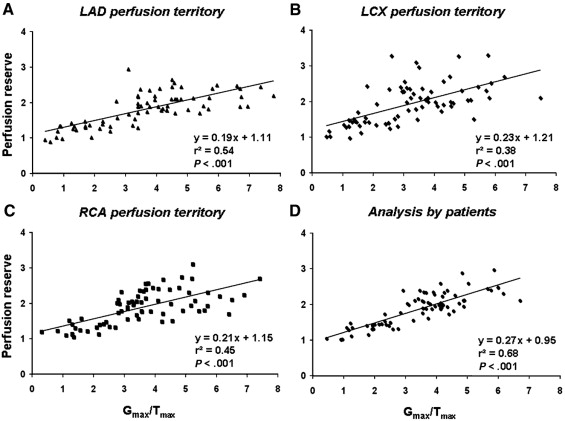

Quantitative myocardial blush grade for the detection of cardiac allograft vasculopathy
Background: Cardiac allograft vasculopathy (CAV) progressively compromises microvascular perfusion and function in heart transplantation (HTx)-recipients. The aim of our study was to investigate the ability of quantitative myocardial blush grade (MBG) to detect CAV. Methods: In consecutive HTx-recipients (n = 72) who underwent surveillance cardiac catheterization, MBG was assessed visually and quantitatively, by analyzing the time course of contrast agent intensity rise. Hereby, the parameter Gmax/Tmax was calculated as the plateau of grey-level intensity (Gmax) divided by the time-to-peak intensity (Tmax). HTx-recipients and 18 healthy volunteers underwent cardiac magnetic resonance, to assess diastolic strain rates and myocardial perfusion reserve during pharmacologic hyperemia. Results: Significant correlations were observed between Gmax/Tmax with perfusion reserve and with mean diastolic strain rates (r2 = 0.68 and r2 = 0.58, P < .001 for both). Visual and quantitative MBG using a cutoff value of Gmax/Tmax = 2.7/s yielded significantly higher accuracy than stenosis severity on coronary angiograms for the detection of impaired microvascular integrity as a surrogate marker for CAV (AUC = 0.78, SE = 0.06, 95% CI = 0.66-0.87 for lumen narrowing versus AUC = 0.91, SE = 0.03, 95%CI = 0.84-0.97 for Gmax/Tmax; P < .01). Furthermore, quantitative MBG provided more robust prediction of survival (χ2= 14.0, P < .001), compared to visually estimated blush (χ2= 5.4, P = .02) and to coronary lumen narrowing assessment, (χ2= 4.8, P = .04). Conclusions: Quantification of MBG can be performed on coronary angiograms of HTx-recipients, and may help with the identification of early CAV in patients with impaired perfusion reserve but without angiographically evident atherosclerosis. © 2010 Mosby, Inc. All rights reserved.